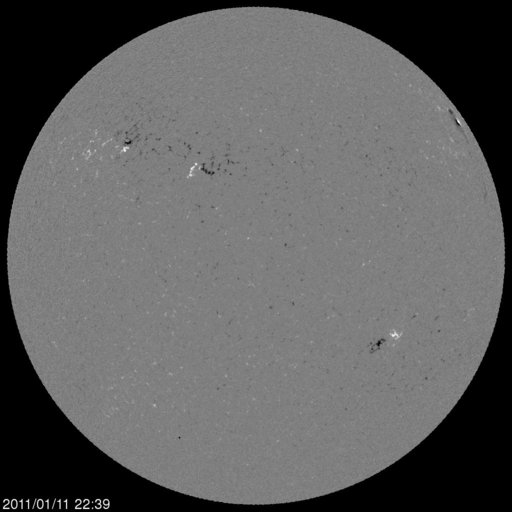|
SOHO SATELLITE IMAGES
WHITE-LIGHT
 |
MDI MAGNETOGRAM
 |
MDI CONTINUUM
 |
EIT 304
 |
EIT 195
 |
EIT 171
 |
LASCO C3
 |
LASCO C2
 |
AURORAL ACTIVITY
 |
MDI CONTINUUM
MDI or Michelson Doppler Imager continuum image of the sun.
MDI MAGNETOGRAM
MDI or Michelson Doppler Imager magnetogram image of the sun.
EIT
The EIT (Extreme ultraviolet Imaging Telescope) images the solar atmosphere
at several wavelengths. Each wavelength corresponds to a different temperature.
The temperatures are:
- 302 Angstrom: 80,000 degrees Kelvin
- 284 Angstrom: 2,000,000 degrees Kelvin
- 195 Angstrom: 1,500,000 degrees Kelvin
- 171 Angstrom: 1,000,000 degrees Kelvin
The hotter the temperature, the higher you are looking in the solar atmosphere.
LASCO
LASCO (Large Angle Spectrometric Coronograph) is able to take images of the
solar corona by blocking light coming directly from the Sun with an occulter
disk, creating an artificial eclipse within the instrument itself. The position
of the solar disk is indicated in the images by the white circle. The most
prominent feature of the corona are usually the coronal streamers, those nearly
radial bands that can be seen both in C2 and C3. Occasionally, a coronal mass
ejection can be seen being expelled away from the Sun and crossing the fields of
view of both coronagraphs. The shadow crossing from the lower left corner to the
center of the image is the support for the occulter disk.
LASCO C2 images show the inner solar corona up to 8.4 million kilometers (5.25
million miles) away from the Sun.
LASCO C3 images have a larger field of view. They encompass 32 diameters of the
Sun. To put this in perspective, the diameter of the images is 45 million
kilometers (30 million miles) at the distance of the Sun, or half of the
diameter of the orbit of Mercury. Many bright stars can be seen behind the Sun.
BIG BEAR
SOLAR OBSERVATORY
GONG+
INTENSITY IMAGE
 |
GONG+
MAGNETOGRAM
 |
FULL DISK
H-ALPHA
 |
CONTRAST
ENHANCED FULL DISK H-ALPHA
 |
|
|
FULL DISK WHITE-LIGHT
The image was recorded with a 8-bit Kodak MegaPlus 1.4i CCD camera.
CONTRAST ENHANCED FULL DISK WHITE-LIGHT
The image was recorded with a 8-bit Kodak MegaPlus 1.4i CCD camera. This image
has been corrected by dark and flat field images, and a limb darkening estimate
has been subtracted to enhance the contrast.
FULL DISK CaK-LINE
The image was recorded with a 8-bit Kodak MegaPlus 1.4i CCD camera.
CONTRAST ENHANCED FULL DISK Ca-K-LINE
The image was recorded with a 8-bit Kodak MegaPlus 1.4i CCD camera. The FWHM of
the Daystar filter amounts to 0.1 nm. This image has been corrected by dark and
flat field images, and a limb darkening estimate has been subtracted to enhance
the contrast. We use the CaK-line images to produce a daily index of the CaK-line
activity.
GONG+ MAGNETOGRAM
This solar magnetic field map was recorded by the Big Bear GONG+ instrument and
scaled so that the darkest pixels are -100 gauss and the brightest pixels are
+100 gauss. For additional images from other GONG sites see the GONG Daily
Images page. For more information about the GONG see the GONG project.
FULL DISK H-ALPHA
The image was recorded with a 14-bit, 2032 x 2032 pixel Apogee KX4 CCD camera.
CONTRAST ENHANCED FULL DISK H-ALPHA
The best daily panoramic solar image ever! The image was recorded with a 14-bit,
2032 x 2032 pixel Apogee KX4 CCD camera. This image has been corrected by dark
and flat field images, and a limb darkening estimate has been subtracted to
enhance the contrast.
MAUNA LOA SOLAR
OBSERVATORY
ACOS MARK4
 |
ACOS PICS LIMB
 |
ACOS PICS DISC
 |
ACOS CHIP
 |
PSPT CaIIk
 |
PSPT BLUE
 |
PSPT RED
 |
ECHO SAMPLE
VELOCITY IMAGE
 |
|
ACOS
ACOS (Advanced Coronal Observing System) is a suite of instruments designed to
observe the solar atmosphere at a variety of heights. Includes Chromospheric
Helium Imaging Photometer (CHIPS, 1083.0 nm), H-alpha prominence and solar disk
monitor (PICS, 656.2 nm), and the Mk4 K-coronameter, which observes the white
light K-corona from 1.12-2.79 solar radii.
ECHO
ECHO (Experiment for Coordinated Helioseismic Observations). A network of
two instruments which observe solar oscillations as seen in the radial velocity
of the solar surface.
PSPT
PSPT (Precision Solar Photometric Telescope) observes the solar disk in three
bandpasses: 605-610 nm (red), 408-412 nm (blue), and 393 nm (CaIIK).
|




















